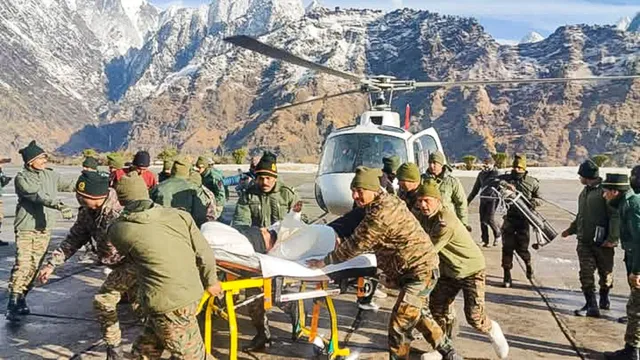A catastrophic avalanche struck a remote construction camp in Uttarakhand, India, burying more than 50 workers under massive layers of snow and debris. The disaster, which occurred near a hydroelectric project site in the mountainous region, has triggered a frantic rescue operation as authorities grapple with freezing temperatures, unstable terrain, and the looming threat of additional avalanches.
The Incident: Timeline and Immediate Impact
The avalanche hit during the early hours, engulfing the camp located in the Tapovan-Rishiganga area—a zone prone to extreme weather and geological instability. The workers were part of a team constructing the Rishiganga Hydroelectric Project, a venture aimed at harnessing the region’s hydropower potential.
Initial reports suggest the avalanche was triggered by a glacier breach or sudden snowfall, though experts are investigating the exact cause. The force of the snowslide demolished infrastructure, including barracks and machinery, leaving dozens trapped under up to 10 feet of snow and rubble. Local authorities confirmed 7 fatalities within hours, with fears the death toll could rise sharply as rescue teams reach deeper into the wreckage.
Rescue Operations: A Race Against Time
Over 250 personnel from India’s National Disaster Response Force (NDRF), Indo-Tibetan Border Police (ITBP), and local agencies are leading the rescue efforts. Their challenges are immense:
- Harsh Weather: Sub-zero temperatures and heavy snowfall are hampering visibility and equipment functionality.
- Unstable Terrain: The risk of secondary avalanches and landslides has forced intermittent pauses in operations.
- Remote Location: The camp’s inaccessibility—a 10-hour trek from the nearest town—delays the deployment of heavy machinery.
Rescuers are using thermal imaging drones, sniffer dogs, and manual digging to locate survivors. On-site medical teams have set up temporary clinics, but hopes are dimming as the critical 48-hour window for survival closes.

Human Toll and Anguish
Most of the trapped workers are migrant laborers from impoverished regions of India, including Bihar and Uttar Pradesh. Families have gathered at the disaster site, desperate for updates. Rajesh Kumar, whose brother is among the missing, told reporters:
“We’re praying for a miracle, but every hour feels like a lifetime.”
Uttarakhand Chief Minister Pushkar Singh Dhami visited the site, vowing “all possible resources” for the rescue. Meanwhile, Prime Minister Narendra Modi announced compensation of ₹2 lakh (approx. $2,400) for each victim’s family—a gesture critics call “inadequate” given systemic neglect of labor safety.
Broader Implications: A Region at Risk
Uttarakhand, nestled in the fragile Himalayas, has witnessed repeated tragedies linked to climate change and unchecked development. The 2021 Chamoli disaster—a glacial flood that killed over 200—highlighted the ecological risks of hydroelectric projects in seismically active zones. Environmentalists argue that deforestation and aggressive infrastructure development exacerbate disasters.
Anil Joshi, an environmental scientist, stated:
“These projects prioritize energy over ecology. The Himalayas are sending a clear warning: unsustainable development will cost lives.”
Global Reactions and Solidarity
Pakistan’s Foreign Ministry expressed condolences, emphasizing regional solidarity in times of crisis. International organizations, including the UN Office for Disaster Risk Reduction, have called for stricter enforcement of safety protocols in vulnerable zones.
Looking Ahead: Accountability and Prevention
While rescue efforts remain the priority, questions loom about accountability:
- Why was the camp operational during peak avalanche season?
- Were workers adequately trained for emergencies?
- Have environmental impact assessments been ignored?
The Uttarakhand High Court has announced plans to audit all hydroelectric projects in the state, signaling a potential shift toward stricter regulations.
Conclusion: A Wake-Up Call for Sustainable Development
The Uttarakhand avalanche is more than a natural disaster—it’s a stark reminder of the human cost of ecological negligence. As climate change intensifies, balancing development with environmental stewardship becomes non-negotiable. For now, the world watches as rescuers brave the elements, clinging to hope amid the snow and silence.
For real-time updates on the rescue efforts, follow #UttarakhandRescue on social media.
Keywords: Uttarakhand avalanche, Rishiganga hydroelectric project, NDRF rescue, climate disaster, worker safety, Himalayan ecology
ScaleUp Pakistan – Covering critical developments in South Asia’s environment, infrastructure, and humanitarian challenges.
Note: Update casualty figures and rescue progress as official reports emerge.










